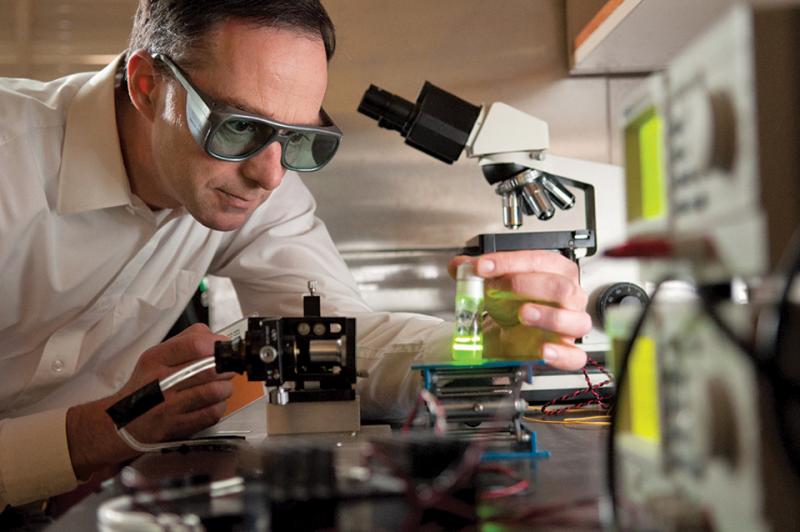US patent for UVic process to battle cancer
- Patty Pitts

Chemistry professor Dr. Frank van Veggel likes to work with extremely small particles and very big ideas. He’s developed a process whereby nanoparticles, each 10 times smaller than a speck of dust, could someday assist oncologists better identify and target cancerous tumours and, in some cases, eliminate the need for painful and potentially dangerous biopsies.
His optimistic view is shared by the US Patent Office which granted a patent on Feb. 11 for van Veggel’s process involving synthesizing nanoparticles of the lanthanides sodium and fluoride. Lanthanides, which are available in small amounts throughout the world, are a family of 14 elements with unique optical and magnetic properties. While a Canadian patent application is currently being reviewed by the Canadian Intellectual Property Office and will likely be issued in the near future, a US patent can produce bigger rewards.
“The patent gets companies interested in supporting further research,” says van Veggel. “You want to cover the US because the potential market is so big and there’s a greater potential to access venture capital.”
Using one of UVic’s advanced electron microscopes, van Veggel and his team of eight to 10 researchers need about a week to synthesize a vial of lanthanide nanoparticles in water which is then sent to a collaborator at the University of Calgary for further lab tests involving MRI technology. Lanthanides are used in lasers, telecommunications equipment, MRI machines and ultra strong magnets.
Technicians add a contrast agent to about 60 per cent of all cancer-related MRIs to enhance the image contrast between the tumour and the surrounding tissue. But these contrast agents are not effective in the MRIs with higher magnetic fields used for research purposes and to develop the models that will ultimately be used to treat humans.
van Veggel’s patented process does provide higher image contrast in research MRIs, opening the door to develop protocols that will later be put to use in hospitals.
“Following injection prior to an MRI, the nanoparticles will not only inform a surgeon as to the location of a tumour but also provide a better image of its shape which helps surgeons determine how much surrounding tissue needs to be removed,” says van Veggel. “We hope to make the material so potent that we will be able to find very small tumours.”
He thinks his new process might even eliminate the need for some biopsies. “With a lot of work we can produce antibodies or biomarkers particular to specific forms of cancer and connect them to our nanoparticles. When they localize on a malignant tumour, they both confirm a malignancy and provide additional information about the cancer in question to the oncologist.”
van Veggel thinks it will be about 10 years before human applications are possible but he’s optimistic about the potential for the new process.
“There are currently a lot of false positive cancer diagnoses and a lot of false negative diagnoses and both are highly undesirable,” says van Veggel. “If we can come up with better imaging methods the entire diagnostic process becomes way more effective.
“In diseases such as prostate cancer there are a lot of unnecessary interventions” he adds. “Once our process is ready for human use we’ll be able to differentiate between smaller, less aggressive tumours but also find small metastasized ones.”

